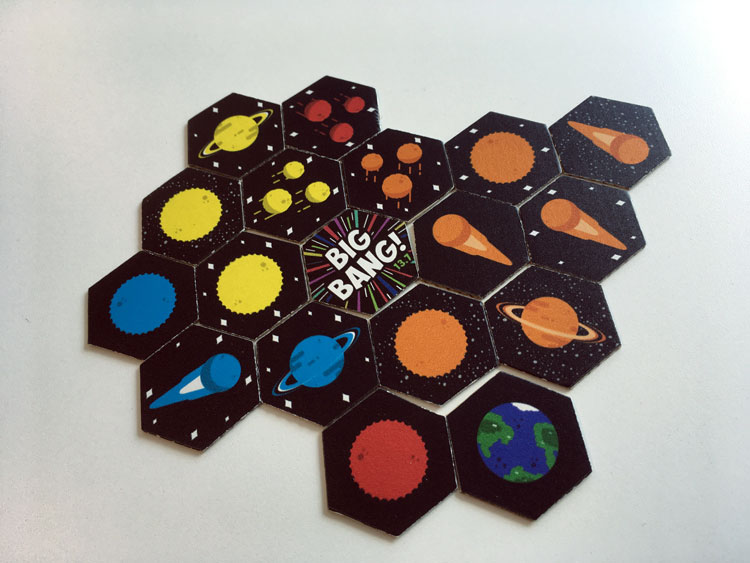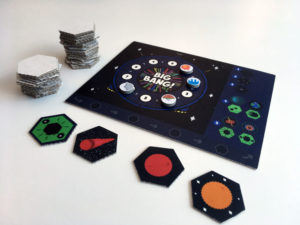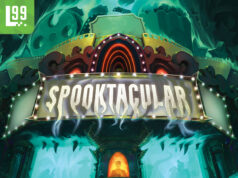Note: This preview uses pre-release components and rules. What you see here may be different from the final, published game.This post was a paid preview, you can find out more information here.
 There are an incredibly small number of games that deal with the organization and manipulation of the universe. Moving planets and stars may be a bit too large of a scale for many players, especially as it involves taking a pseudo-supernatural role in shaping things. If, however, gamers are interested in phenomenal cosmic power, a new game from Invedars will happily provide relief from the drought.
There are an incredibly small number of games that deal with the organization and manipulation of the universe. Moving planets and stars may be a bit too large of a scale for many players, especially as it involves taking a pseudo-supernatural role in shaping things. If, however, gamers are interested in phenomenal cosmic power, a new game from Invedars will happily provide relief from the drought.
Big Bang 13.7 is a tile placement and manipulation game for 2-4 players that takes about 30-45 minutes to play. It plays well with any number of players.
Game Overview:
Players in Big Bang 13.7 (hereafter just referred to as Big Bang) take the role of galactic, supreme forces or gods (if you prefer). They shape the cosmos by playing hexagonal tiles representing stars, planets and other cosmological bodies. At the end of the game, players will score points by making sure tiles that match their objectives line up.
How to Play:

The setup involves creating stacks of hexagon tiles which have 3 artistic elements: background star field, color of object (orange, blue, yellow, red), and type of object (planet, sun, comets, asteroids). A main board with reference information tracks the turn order. Each player will randomly take two secret objective cards: one for color and one for celestial body type.
With every turn, players will take the same two actions: play a tile (from the four available) and move their pawn forward on the “Cosmic Clock”. The player in last place on the Cosmic Clock then takes the next turn.
Play a Tile
When playing a tile, players need to initially place next to the Big Bang tile, but later will need to match the tile to adjacent tiles by one property (star field, color, type). For example, a blue star can be placed next to a blue comet and a red star. Each tile must be placed next to two other tiles, and the main objective is to line up at least 3 celestial bodies of the player’s objective color/type with tiles featuring the most valuable star fields.

In addition to the basic Celestial Body tiles, there are other galactic phenomena which can move or flip (cancel) tiles. These are to be played very carefully with special attention to the background star field of existing tiles in order to gain the most benefit.
Move the Cosmic Clock
Once a player is finished, the player moves their token forward on the Cosmic Clock based on the star field background of the tile placed. The next player in turn is the player whose token is in last place. This can can result in multiple turns for the same player, something very advantageous in this type of game.
With each turn, a single tile from the remaining three tiles not played will be placed in a discard pile. Once the initial stack of tiles has been exhausted, the discards form a new stack and the selection and playing process repeats until all tiles have been played.
At the end of the game, players score points for each aligned celestial body in an arrangement of three or more. Points are based on the star field of the tile and the player with the most points wins.

Game Experience:
On the outset, Big Bang seems like a light and friendly game. This could not be further from the truth. There is some real cosmic bite in this game. Players who find themselves without a tile of their own color or type to place will invariably place something to disrupt other players. There’s a considerable amount of back and forth here, including making a play to intentionally cause a tile to be discarded. With all the aggressive play, it’s exciting to get even three shapes lined up. Players who play friendly will find that they’re just in a race to see who can get certain tiles first.

The other twists are the varied special action tiles which can do some extraordinary things and amazingly follow the theme pretty well. A wormhole tile connects different areas of space to allow for longer alignments of objects. A black hole, one of the heaviest hitting tiles, flips neighboring tiles, canceling their placement and anything else placed next to it.
The prototype components are simple cardboard, but this is just the type of game that deserves heavy tiles. The overall gameplay feels like a mix of dominoes and UNO (not a bad thing for a light game) in a hexagonal format. There is certainly room for improvement with the art and components, but the existing graphic design makes it easy enough to see differences in the tiles for scoring.
Final Thoughts:
Big Bang 13.7 is a solid filler. It’s not going to blow back any hair with mechanisms, but what it delivers is a great tug-of-war for galactic control. Even though it runs a little long for what it is, it’s very enjoyable. The main thing Invedars could do to improve it would be more photorealistic art, but that gets in the way of easily identifying icons. There are also rules included for toning the game down for kids. All in all, with a nearly unique theme and familiar, challenging gameplay, Big Bang 13.7 should be a good time for almost any group.
Big Bang 13.7 is now in funding on Kickstarter, so be sure to check out their campaign page if you’d like more information on the game or to become a backer.
As always, we don’t post ratings for preview copies as the components and rules may change from the final game. Check back with us after the game is produced for a full review. This post was a paid preview, you can find out more information here.





















